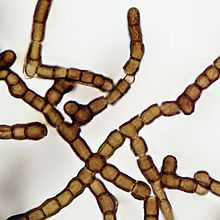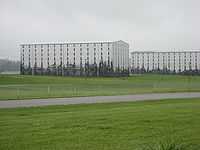Baudoinia compniacensis
| Baudoinia compniacensis | |
|---|---|
 | |
| Photomicrograph of colony growing on Modified Leonian's agar | |
| Scientific classification | |
| Kingdom: | Fungi |
| Phylum: | Ascomycota |
| Class: | Dothideomycetes |
| Subclass: | Dothideomycetidae |
| Order: | Capnodiales |
| Family: | Teratosphaeriaceae |
| Genus: | Baudoinia |
| Species: | B. compniacensis |
| Binomial name | |
| Baudoinia compniacensis (Richon) J.A. Scott & Unter. | |
| Synonyms | |
|
Torula compniacensis Richon. 1881 | |
Baudoinia compniacensis is a sac fungus that has been observed on a wide range of substrates in the vicinity of distilleries, spirits maturation facilities, bonded warehouses, and bakeries. The fungus is a habitat coloniser with a preference for airborne alcohol.[1][2]
Description
Mycelium black, effused, velvety to crust-like. Vegetative hyphae dark brown, thick-walled, often moniliform. Distinctive conidiophores lacking. Conidiogenous cells integrated within vegetative hyphae. Conidia dry, nonseptate or uniseptate at the median, thick-walled, globose to barrel-shaped, brown to black, typically with coarse surface ornamentation, dehiscencing by schizolysis. Ramoconidia absent. Colonies on MLA slow growing, darkly pigmented. Synanamorphs absent, Teleomorph unknown.[1]
Nutrition
Baudoinia species use ethanol for their carbon nutrition, however growth rates suggest that this is not their only source of nutrition. Ethanol in vapour form also accelerates the growth of the fungus and stimulates spore germination. The ability to withstand high temperatures and therefore colonise habitats such as roofing may be explained by the observation that ethanol vapour stimulates the formation of special heat-protective proteins that prevent cells from being killed under these relatively extreme conditions.[3]
Ecology
Baudoinia compniacensis is black in colour and is partly responsible for the frequently observed phenomenon of 'Warehouse Staining', reported originally from the walls of buildings near brandy maturation warehouses in Cognac, France. Baudoinia compniacensis is a cosmopolitan colonist of outdoor surfaces subjected to extreme daily temperature shifts, elevated high relative humidity, periodic wetting, and ambient airborne ethanol.[3] It is known from a wide range of substrates. For example, the University of Alberta Microfungus Collection and Herbarium[4] lists isolates recovered from tree bark,[lower-alpha 1] concrete,[lower-alpha 2] PVC plastic,[lower-alpha 3] galvanized roofing,[lower-alpha 4] masonry,[lower-alpha 5] and stone.[lower-alpha 6]
Baudoinia compniacensis is not uniquely associated with spirit maturation and manufacture as one sample examined came from a commercial bakery. Ethanol vapor appears to be important in habitat determinant and Baudoinia species may occur in association with natural fermentative processes, such as seasonal fruit drops, bogs, natural composts, etc.[1] B. compniacensis may also occur around places where automotive fuel is stored or transferred, as ethanol is required to be blended in gasoline in most countries. For example, in the United States the Energy Policy Act of 2005 requires ethanol to be blended in gasoline at a minimum of 5.9%, but may be as high as 10% depending on the state.
It has been recorded as a well utilised food source of snails and slugs through the radula marks left following grazing.[1]
Distribution
B. compniacensis was first investigated in 1872 when Michel Charles Durieu de Maisonneuve and Casimir Roumeguère examined a black, sooty growth found on the walls and roof tiles of buildings near distilleries in Cognac, France at the instigation of the French pharmacist Antonin Baudoin.[1] It has been widely recorded in Asia, Europe and the Americas.[1]
B. compniacensis on buildings and plants
Although the fungus forms a coating layer on tree bark, this slow growing species does not seem to harm the plants by blocking the lenticels or significantly reduce their growth rates. Deciduous species also have the extra benefit of developing new leaves annually.
The fungus can be removed from buildings using high pressure water jets, bleach, etc. and has not be shown to cause anything other than cosmetic effects[5] thanks to its mode of nutrition via the atmosphere that does not involve the decay of wood, stone, etc. Mosses, lichens and algae also grow on solid vertical surfaces, slopes, etc. in the same fashion as the Angel's Share fungus and do not damage the infrastructure of built structures.
-
Sycamore branches showing one with and the other without the Angels' Share fungus coating.
-

Angel's share fungus blackening a Diageo bonded warehouse in Clackmannanshire, Scotland.
-

Heaven Hill distillery in Bardstown, Kentucky, US where fungus is visible on the white warehouses.
-
Acer pseudoplatanus twig from Beith, North Ayrshire, Scotland.
Genome Sequence
| NCBI genome ID | 3225 |
|---|---|
| Ploidy | haploid |
| Genome size | 21.88 Mb |
| Year of completion | 2011 |
The genome of B. compniacensis was completed by the United States Department of Energy's Joint Genome Institute in 2011, using Roche (454), Sanger fosmid, and Illumina sequence data. The completed assembly is 21.88 Mb in size.[6]
Related fungi
The most closely related ascommycetes to Baudoinia compniacensis appear to be members of the genera Friedmanniomyces and Trimmatostroma. Friedmanniomyces species are rock-inhabiting species known only from the Antarctic.[1] This fits in well with the observed fact that the species favours surfaces that are subjected to great environmental exposure, as in roofing materials that experience extreme diurnal fluctuations in ambient conditions.[1]
Notes
References
- ↑ 1.0 1.1 1.2 1.3 1.4 1.5 1.6 1.7 Mycologia Retrieved : 2011-04-21
- ↑ Byland, Hannah (September 4, 2012). "Whiskey Aging Warehouses and the Effects to Surrounding Residential Neighborhoods in Louisville, Ky." (PDF). Louisville, Kentucky: Louisville, Kentucky government. Retrieved July 30, 2014.
- ↑ 3.0 3.1 Baudoinia Retrieved : 2011-04-21
- ↑ 4.0 4.1 4.2 4.3 4.4 4.5 4.6 Sigler, L. "UAMH Culture Collection Catalogue". University of Alberta Microfungus Collection and Herbarium. University of Alberta/ Devonian Botanic Garden.
- ↑ APCD Report
- ↑ Ohm, RA; Feau, N; Henrissat, B; Schoch, CL; Horwitz, BA; Barry, KW; Condon, BJ; Copeland, AC; Dhillon, B; Glaser, F; Hesse, CN; Kosti, I; LaButti, K; Lindquist, EA; Lucas, S; Salamov, AA; Bradshaw, RE; Ciuffetti, L; Hamelin, RC; Kema, GH; Lawrence, C; Scott, JA; Spatafora, JW; Turgeon, BG; de Wit, PJ; Zhong, S; Goodwin, SB; Grigoriev, IV (2012). "Diverse lifestyles and strategies of plant pathogenesis encoded in the genomes of eighteen Dothideomycetes fungi.". PLoS Pathogens 8 (12): e1003037. doi:10.1371/journal.ppat.1003037. PMC 3516569. PMID 23236275.
External links
- The Angel's Share Fungus on tree bark, etc in Ayrshire, Scotland
- Index Fungorum
- USDA ARS Fungal Database
- US DOE JGI Genome Sequence Page for B. compniacensis
- S1 Beith
- Rogers, Adam (May 17, 2011). "The Mystery of the Canadian Whiskey Fungus". Wired 19 (06).
- Ryzik, Melena (Aug 29, 2012). "Kentuckians Take Distilleries to Court Over Black Gunk". New York Times.
| Wikimedia Commons has media related to Baudoinia compniacensis. |